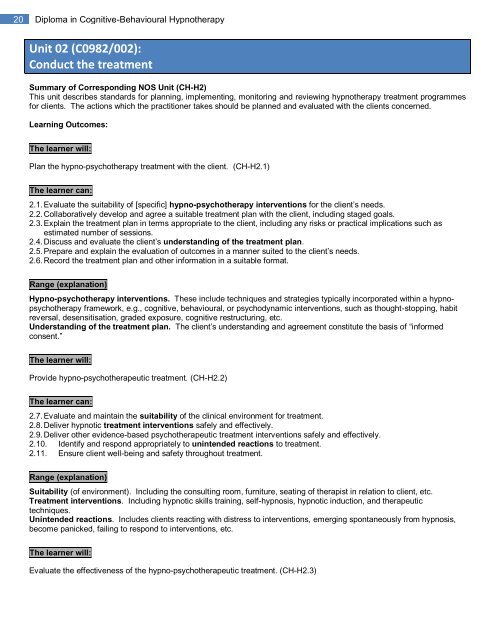Diploma in Cognitive-Behavioural Hypnotherapy - REBHP
Diploma in Cognitive-Behavioural Hypnotherapy - REBHP
Diploma in Cognitive-Behavioural Hypnotherapy - REBHP
Create successful ePaper yourself
Turn your PDF publications into a flip-book with our unique Google optimized e-Paper software.
20 <strong>Diploma</strong> <strong>in</strong> <strong>Cognitive</strong>-<strong>Behavioural</strong> <strong>Hypnotherapy</strong>Unit 02 (C0982/002):Conduct the treatmentSummary of Correspond<strong>in</strong>g NOS Unit (CH-H2)This unit describes standards for plann<strong>in</strong>g, implement<strong>in</strong>g, monitor<strong>in</strong>g and review<strong>in</strong>g hypnotherapy treatment programmesfor clients. The actions which the practitioner takes should be planned and evaluated with the clients concerned.Learn<strong>in</strong>g Outcomes:The learner will:Plan the hypno-psychotherapy treatment with the client. (CH-H2.1)The learner can:2.1. Evaluate the suitability of [specific] hypno-psychotherapy <strong>in</strong>terventions for the client‘s needs.2.2. Collaboratively develop and agree a suitable treatment plan with the client, <strong>in</strong>clud<strong>in</strong>g staged goals.2.3. Expla<strong>in</strong> the treatment plan <strong>in</strong> terms appropriate to the client, <strong>in</strong>clud<strong>in</strong>g any risks or practical implications such asestimated number of sessions.2.4. Discuss and evaluate the client‘s understand<strong>in</strong>g of the treatment plan.2.5. Prepare and expla<strong>in</strong> the evaluation of outcomes <strong>in</strong> a manner suited to the client‘s needs.2.6. Record the treatment plan and other <strong>in</strong>formation <strong>in</strong> a suitable format.Range (explanation)Hypno-psychotherapy <strong>in</strong>terventions. These <strong>in</strong>clude techniques and strategies typically <strong>in</strong>corporated with<strong>in</strong> a hypnopsychotherapyframework, e.g., cognitive, behavioural, or psychodynamic <strong>in</strong>terventions, such as thought-stopp<strong>in</strong>g, habitreversal, desensitisation, graded exposure, cognitive restructur<strong>in</strong>g, etc.Understand<strong>in</strong>g of the treatment plan. The client‘s understand<strong>in</strong>g and agreement constitute the basis of ―<strong>in</strong>formedconsent.‖The learner will:Provide hypno-psychotherapeutic treatment. (CH-H2.2)The learner can:2.7. Evaluate and ma<strong>in</strong>ta<strong>in</strong> the suitability of the cl<strong>in</strong>ical environment for treatment.2.8. Deliver hypnotic treatment <strong>in</strong>terventions safely and effectively.2.9. Deliver other evidence-based psychotherapeutic treatment <strong>in</strong>terventions safely and effectively.2.10. Identify and respond appropriately to un<strong>in</strong>tended reactions to treatment.2.11. Ensure client well-be<strong>in</strong>g and safety throughout treatment.Range (explanation)Suitability (of environment). Includ<strong>in</strong>g the consult<strong>in</strong>g room, furniture, seat<strong>in</strong>g of therapist <strong>in</strong> relation to client, etc.Treatment <strong>in</strong>terventions. Includ<strong>in</strong>g hypnotic skills tra<strong>in</strong><strong>in</strong>g, self-hypnosis, hypnotic <strong>in</strong>duction, and therapeutictechniques.Un<strong>in</strong>tended reactions. Includes clients react<strong>in</strong>g with distress to <strong>in</strong>terventions, emerg<strong>in</strong>g spontaneously from hypnosis,become panicked, fail<strong>in</strong>g to respond to <strong>in</strong>terventions, etc.The learner will:Evaluate the effectiveness of the hypno-psychotherapeutic treatment. (CH-H2.3)


